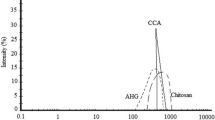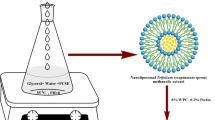Abstract
Garcinia mangostana pericarp is a good source of natural antioxidants with numerous functional properties. The conventional approaches for the recovery of antioxidants from Garcinia mangostana pericarp require long processing time and high temperature, which may cause degradation or loss of bioactivity of antioxidants, and often result in low recovery efficiency. In this study, the extraction of antioxidants from Garcinia mangostana pericarp was investigated using a polyethylene glycol (PEG)/citrate aqueous biphasic system (ABS) with the addition of surfactants. The optimum condition for the recovery of antioxidants was achieved in PEG 1000/citrate ABS of pH 8 with tie-line length (TLL) of 48.3% (w/w), volume ratio (VR) of 1.6, 0.2% (w/w) sample loading and addition of 1.0% (w/w) Tween 85. The antioxidants were recovered in the PEG-rich top phase with a high K value of 18.23 ± 0.33 and a recovery yield of 92.01% ± 0.09. The findings suggested that the addition of surfactants to polymer/salt ABS can enhance the recovery of antioxidants from Garcinia mangostana pericarps by conserving the antioxidative properties.





Similar content being viewed by others
References
Kim, H., Moon, J. Y., Kim, H., Lee, D.-S., Cho, M., Choi, H.-K., Kim, Y. S., Mosaddik, A., & Cho, S. K. (2010). Antioxidant and antiproliferative activities of mango (Mangifera indica L.) flesh and peel. Food Chemistry, 121, 429–436.
Nurliyana, R., Syed Zahir, I., Mustapha Suleiman, K., Aisyah, M. R., & Kamarudin, K. R. (2010). Antioxidant study of pulps and peels of dragon fruits: a comparative study. International Food Research Journal, 17, 367–375.
Yang, X., Yan, F., Huang, S., & Fu, C. (2014). Antioxidant activities of fractions from longan pericarps. Food Science and Technology, 34, 341–345.
Riyanto, S., & Rohman, A. (2017). Antioxidant activities of rambutan (Nephelium lappaceum L) peel in vitro. Food Research, 2, 119–123.
Suttirak, W., & Manurakchinakorn, S. (2014). In vitro antioxidant properties of mangosteen peel extract. Journal of Food Science and Technology, 51(12), 3546–3558.
Lerslerwong, L., Rugkong, A., Imsabai, W., & Ketsa, S. (2013). The harvest period of mangosteen fruit can be extended by chemical control of ripening—a proof of concept study. Scientia Horticulturae, 157, 13–18.
Seesom, W., Jaratrungtawee, A., Suksamrarn, S., Mekseepralard, C., Ratananukul, P., & Sukhumsirichart, W. (2013). Antileptospiral activity of xanthones from Garcinia mangostana and synergy of gamma-mangostin with penicillin G. BMC Complementary and Alternative Medicine, 13, 182–182.
Aizat, W. M., Ahmad-Hashim, F. H., & Syed Jaafar, S. N. (2019). Valorization of mangosteen, “the queen of fruits,” and new advances in postharvest and in food and engineering applications: a review. Journal of Advanced Research, 20, 61–70.
Kusmayadi, A., Adriani, L., Abun, A., Muchtaridi, M., & Hidayat Tanuwiria, U. (2019). Antioxidant activity of mangosteen peel (Garcinia mangostana L.) extracted using different solvents at the different times. Drug Invention Today, 11, 44–48.
Fang, L., Liu, Y., Zhuang, H., Liu, W., Wang, X., & Huang, L. (2011). Combined microwave-assisted extraction and high-speed counter-current chromatography for separation and purification of xanthones from Garcinia mangostana. Journal of Chromatography B, 879, 3023–3027.
Dai, J., & Mumper, R. J. (2010). Plant phenolics: extraction, analysis and their antioxidant and anticancer properties. Molecules, 15(10), 7313–7352.
Iqbal, M., Tao, Y., Xie, S., Zhu, Y., Chen, D., Wang, X., Huang, L., Peng, D., Sattar, A., Shabbir, M. A. B., Hussain, H. I., Ahmed, S., & Yuan, Z. (2016). Aqueous two-phase system (ATPS): an overview and advances in its applications. Biological Procedures Online, 18, 18.
Gupta, R., Bradoo, S., & Saxena, R. K. (1999). Aqueous two-phase systems: an attractive technology for downstream processing of biomolecules. Current Science, 77, 520–523.
Yuan, C., Xu, Z., Fan, M., Liu, H., Xie, Y., & Zhu, T. (2014). Study on characteristics and harm of surfactants. Journal of Chemical and Pharmaceutical, 6, 2233–2237.
Hosseinzadeh, R., Khorsandi, K., & Hemmaty, S. (2013). Study of the effect of surfactants on extraction and determination of polyphenolic compounds and antioxidant capacity of fruits extracts. PLoS One, 8, e57353.
Sharma, S., Kori, S., & Parmar, A. (2015). Surfactant mediated extraction of total phenolic content (TPC) and antioxidants from fruits juices. Food Chemistry, 185, 284–288.
Ng, H. S., Tan, C., Chen, S., Mokhtar, M., Ariff, A., & Ling, T. (2011). Primary capture of cyclodextrin glycosyltransferase derived from Bacillus cereus by aqueous two phase system. Separation and Purification Technology, 81, 318–324.
Zhang, D., Zu, T., Fu, Y., Wang, W., Zhang, L., Luo, M., Mu, F., Yao, X., & Duan, M. (2013). Aqueous two-phase extraction and enrichment of two main flavonoids from pigeon pea roots and the antioxidant activity. Separation and Purification Technology, 102, 26–33.
Ng, H. S., Tan, G., Lee, K.-H., Zimmermann, W., Yim, H. S., & Lan, J. C.-W. (2018). Direct recovery of mangostins from Garcinia mangostona pericarps using cellulas-assisted aqeuous micellar biphasic system with recyclable surfactant. Journal of Bioscience and Bioengineering, 126(4), 507–513.
Tan, G., Zimmermann, W., Lee, K.-H., Lan, J. C.-W., Yim, H. S., Ling, T., & Ng, H. S. (2017). Recovery of mangostins from Garcinia mangostana peels with an aqueous micellar biphasic system. Food and Bioproducts Processing, 102, 233–240.
Ho, S. L., Lan, J. C.-W., Tan, J. S., Yim, H. S., & Ng, H. S. (2017). Aqueous biphasic system for the partial purification of Bacillus subtilis carboxymethyl cellulase. Process Biochemistry, 58, 276–281.
Chuo, S. C., Mohd-Setapar, S. H., Mohamad-Aziz, S. N., & Starov, V. M. (2014). A new method of extraction of amoxicillin using mixed reverse micelles. Colloids and Surfaces A: Physicochemical and Engineering Aspects, 460, 137–144.
Bi, W., Tian, M., & Row, K. H. (2011). Extraction and concentration of tanshinones in Salvia miltiorrhiza Bunge by task-specific non-ionic surfactant assistance. Food Chemistry, 126(4), 1985–1990.
Chat, O. A., Najar, M. H., Mir, M. A., Rather, G. M., & Dar, A. A. (2011). Effects of surfactant micelles on solubilization and DPPH radical scavenging activity of Rutin. Journal of Colloid and Interface Science, 355(1), 140–149.
Almeida, M. R., Passos, H., Pereira, M. M., Lima, Á. S., Coutinho, J. A. P., & Freire, M. G. (2014). Ionic liquids as additives to enhance the extraction of antioxidants in aqueous two-phase systems. Separation and Purification Technology, 128, 1–10.
Oelmeier, S. A., Dismer, F., & Hubbuch, J. (2012). Molecular dynamics simulations on aqueous two-phase systems - single PEG-molecules in solution. BMC Biophysics, 5, 14.
Chandrasekhar, J., Sonika, G., Madhusudhan, M. C., & Raghavarao, K. S. M. S. (2015). Differential partitioning of betacyanins and betaxanthins employing aqueous two phase extraction. Journal of Food Engineering, 144, 156–163.
Xavier, L., Freire, M., Vidal-Tato, I., & González-Álvarez, J. (2015). Application of aqueous two phase systems based on polyethylene glycol and sodium citrate for the recovery of phenolic compounds from Eucalyptus wood. Maderas: Ciencia y Tecnologia, 17, 345–354.
Mohamed Ali, S., Ling, T. C., Muniandy, S., Tan, Y. S., Raman, J., & Sabaratnam, V. (2014). Recovery and partial purification of fibrinolytic enzymes of Auricularia polytricha (Mont.) Sacc by an aqueous two-phase system. Separation and Purification Technology, 122, 359–366.
Amid, M., Manap, Y., & Zohdi, N. K. (2014). A novel aqueous two phase system composed of a thermo-separating polymer and an organic solvent for purification of thermo-acidic amylase enzyme from red pitaya (Hylocereus polyrhizus) peel. Molecules, 19(5), 6635–6650.
Wan, P. K., Lan, J. C.-W., Chen, P.-W., Tan, J. S., & Ng, H. S. (2018). Recovery of intracellular ectoine from Halomonas salina cells with poly(propylene) glycol/salt aqueous biphasic system. Journal of the Taiwan Institute of Chemical Engineers, 82, 28–32.
Ng, H. S., Ooi, C. W., Show, P. L., Tan, C. P., Ariff, A., Moktar, M. N., Ng, E.-P., & Ling, T. C. (2014). Recovery of Bacillus cereus cyclodextrin glycosyltransferase using ionic liquid-based aqueous two-phase system. Separation and Purification Technology, 138, 28–33.
Shahid,i F., & Yeo, J. (2016). Insoluble-bound phenolics in food. Molecules, 21(9), 1216.
Rahimpour, F., & Baharvand, A. (2019). Phase equilibrium in aqueous two-phase systems containing poly (propylene glycol) and sodium citrate at different pH. World Academy of Science, Engineering and Technology, 59, 126–130.
Li, S., & Cao, X. (2014). Extraction of tea polysaccharides (TPS) using anionic reverse micellar system. Separation and Purification Technology, 122, 306–314.
Funding
This work was financially supported by the UCSI University Pioneer Scientist Incentive Funds under grant number [PROJ-2019-In-FAS-064] and Industry Grant (Proj-In-ALPHA-003) from Alpha Active Industries Sdn Bhd, Selangor, Malaysia; with laboratory support from Faculty of Applied Sciences, UCSI University, Malaysia.
Author information
Authors and Affiliations
Corresponding authors
Additional information
Publisher’s Note
Springer Nature remains neutral with regard to jurisdictional claims in published maps and institutional affiliations.
Rights and permissions
About this article
Cite this article
Ng, HS., Kee, P.E., Tan, G.YT. et al. Surfactant as an Additive for the Recovery of Potent Antioxidants from Garcinia mangostana Pericarps Using a Polymer/Salt Aqueous Biphasic System. Appl Biochem Biotechnol 191, 273–283 (2020). https://doi.org/10.1007/s12010-020-03284-z
Received:
Accepted:
Published:
Issue Date:
DOI: https://doi.org/10.1007/s12010-020-03284-z




